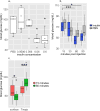Insulin resistance in cavefish as an adaptation to a nutrient-limited environment
- PMID: 29562229
- PMCID: PMC5989729
- DOI: 10.1038/nature26136
Insulin resistance in cavefish as an adaptation to a nutrient-limited environment
Erratum in
-
Author Correction: Insulin resistance in cavefish as an adaptation to a nutrient-limited environment.Nature. 2020 Dec;588(7836):E1. doi: 10.1038/s41586-020-2953-x. Nature. 2020. PMID: 33188369
Abstract
Periodic food shortages are a major challenge faced by organisms in natural habitats. Cave-dwelling animals must withstand long periods of nutrient deprivation, as-in the absence of photosynthesis-caves depend on external energy sources such as seasonal floods. Here we show that cave-adapted populations of the Mexican tetra, Astyanax mexicanus, have dysregulated blood glucose homeostasis and are insulin-resistant compared to river-adapted populations. We found that multiple cave populations carry a mutation in the insulin receptor that leads to decreased insulin binding in vitro and contributes to hyperglycaemia. Hybrid fish from surface-cave crosses carrying this mutation weigh more than non-carriers, and zebrafish genetically engineered to carry the mutation have increased body weight and insulin resistance. Higher body weight may be advantageous in caves as a strategy to cope with an infrequent food supply. In humans, the identical mutation in the insulin receptor leads to a severe form of insulin resistance and reduced lifespan. However, cavefish have a similar lifespan to surface fish and do not accumulate the advanced glycation end-products in the blood that are typically associated with the progression of diabetes-associated pathologies. Our findings suggest that diminished insulin signalling is beneficial in a nutrient-limited environment and that cavefish may have acquired compensatory mechanisms that enable them to circumvent the typical negative effects associated with failure to regulate blood glucose levels.
Conflict of interest statement
The authors declare no competing interests.
Figures












Comment in
-
The healthy diabetic cavefish conundrum.Nature. 2018 Mar 29;555(7698):595-597. doi: 10.1038/d41586-018-03242-0. Nature. 2018. PMID: 29595777 No abstract available.
Similar articles
-
Reproductive adaptation of Astyanax mexicanus under nutrient limitation.Dev Biol. 2025 Jul;523:82-98. doi: 10.1016/j.ydbio.2025.04.006. Epub 2025 Apr 11. Dev Biol. 2025. PMID: 40222642
-
Melanocortin 4 receptor mutations contribute to the adaptation of cavefish to nutrient-poor conditions.Proc Natl Acad Sci U S A. 2015 Aug 4;112(31):9668-73. doi: 10.1073/pnas.1510802112. Epub 2015 Jul 13. Proc Natl Acad Sci U S A. 2015. PMID: 26170297 Free PMC article.
-
Reproductive Adaptation of Astyanax mexicanus Under Nutrient Limitation.bioRxiv [Preprint]. 2025 Feb 17:2025.02.13.638191. doi: 10.1101/2025.02.13.638191. bioRxiv. 2025. Update in: Dev Biol. 2025 Jul;523:82-98. doi: 10.1016/j.ydbio.2025.04.006. PMID: 40027826 Free PMC article. Updated. Preprint.
-
Subterranean life: Behavior, metabolic, and some other adaptations of Astyanax cavefish.J Exp Zool B Mol Dev Evol. 2020 Nov;334(7-8):463-473. doi: 10.1002/jez.b.22948. Epub 2020 Apr 28. J Exp Zool B Mol Dev Evol. 2020. PMID: 32346998 Review.
-
Evolutionary Genetics of the Cavefish Astyanax mexicanus.Adv Genet. 2016;95:117-59. doi: 10.1016/bs.adgen.2016.03.001. Epub 2016 Jun 13. Adv Genet. 2016. PMID: 27503356 Review.
Cited by
-
The somatic genome of Eptatretus okinoseanus reveals the adaptation to deep-sea oligotrophic environment.BMC Genomics. 2024 Aug 27;25(1):807. doi: 10.1186/s12864-024-10727-y. BMC Genomics. 2024. PMID: 39192189 Free PMC article.
-
In-Frame Indel Mutations in the Genome of the Blind Mexican Cavefish, Astyanax mexicanus.Genome Biol Evol. 2019 Sep 1;11(9):2563-2573. doi: 10.1093/gbe/evz180. Genome Biol Evol. 2019. PMID: 31418011 Free PMC article.
-
Major Advances and Discoveries in Diabetes - 2019 in Review.Curr Diab Rep. 2019 Nov 4;19(11):118. doi: 10.1007/s11892-019-1255-x. Curr Diab Rep. 2019. PMID: 31686269 Free PMC article. Review.
-
Stable transgenesis in Astyanax mexicanus using the Tol2 transposase system.Dev Dyn. 2019 Aug;248(8):679-687. doi: 10.1002/dvdy.32. Epub 2019 Apr 15. Dev Dyn. 2019. PMID: 30938001 Free PMC article.
-
Integrating natural history collections and comparative genomics to study the genetic architecture of convergent evolution.Philos Trans R Soc Lond B Biol Sci. 2019 Jul 22;374(1777):20180248. doi: 10.1098/rstb.2018.0248. Epub 2019 Jun 3. Philos Trans R Soc Lond B Biol Sci. 2019. PMID: 31154982 Free PMC article. Review.
References
-
- Culver DC, Pipan T. The Biology of Caves and Other Subterranean Habitats. Oxford Univ. Press; 2009.
-
- Horst Wilkens US. Evolution in the Dark, Darwin’s Loss Without Selection. Springer; 2017.
-
- Hüppop K. Oxygen consumption of Astyanax fasciatus (Characidae, Pisces): a comparison of epigean and hypogean populations. Environ. Biol. Fishes. 1986;17:299–308.
Publication types
MeSH terms
Substances
Grants and funding
LinkOut - more resources
Full Text Sources
Other Literature Sources
Molecular Biology Databases

